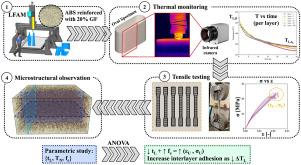Interlayer adhesion in Large Format Additive Manufacturing of glass fiber reinforced ABS structures
IF 6.6
2区 材料科学
Q1 MATERIALS SCIENCE, MULTIDISCIPLINARY
Journal of Materials Research and Technology-Jmr&t
Pub Date : 2025-09-23
DOI:10.1016/j.jmrt.2025.09.149
引用次数: 0
Abstract
Large Format Additive Manufacturing (LFAM) is a promising technology for the rapid production of molds for high-performance composite parts in aerospace and automotive applications. Using ABS reinforced with short glass fibers (20% by weight) as granules improves production rates and mechanical performance. However, interlayer adhesion remains a major challenge, as the interface between layers is typically the weakest point in printed structures. This study examines the effects of three printing parameters on interlayer adhesion: time per layer (), nozzle temperature (), and extrusion factor (). The ABS/20GF composite is first characterized to determine its thermal and physical properties. An infrared camera monitors temperature evolution during printing, and tensile tests with loads applied perpendicular to the printing direction evaluate mechanical performance. Microstructural analysis reveals fracture mechanisms between layers. Results show that interlayer adhesion improves with shorter and higher and values. Thermal monitoring indicates a strong correlation between enhanced strength and reduced temperature gradients between layers, enabling better polymer chain mobility and bonding. ANOVA analysis identifies and as statistically significant factors influencing interlayer adhesion. These findings provide valuable insights for optimizing LFAM process parameters to enhance the structural integrity of fiber-reinforced thermoplastic components.

玻璃纤维增强ABS结构大幅面增材制造中的层间粘合
大尺寸增材制造(LFAM)是一种很有前途的技术,用于快速生产航空航天和汽车领域高性能复合材料零件的模具。用短玻璃纤维增强ABS(重量比20%)作为颗粒,提高了生产率和机械性能。然而,层间粘合仍然是一个主要的挑战,因为层之间的界面通常是印刷结构中最薄弱的环节。本研究考察了三个打印参数对层间粘合的影响:每层时间(tL)、喷嘴温度(TN)和挤出系数(fe)。首先对ABS/20GF复合材料进行表征,确定其热性能和物理性能。红外摄像机监测打印过程中的温度变化,并在垂直于打印方向的负载下进行拉伸测试,以评估机械性能。微观结构分析揭示了层间断裂机制。结果表明,随着tL的缩短和TN、fe值的增大,层间附着力增强。热监测表明,增强的强度与层间温度梯度的降低之间存在很强的相关性,从而实现更好的聚合物链迁移和键合。方差分析表明,tL和fe是影响层间粘附的有统计学意义的因素。这些发现为优化LFAM工艺参数以提高纤维增强热塑性塑料部件的结构完整性提供了有价值的见解。
本文章由计算机程序翻译,如有差异,请以英文原文为准。
求助全文
约1分钟内获得全文
求助全文
来源期刊

Journal of Materials Research and Technology-Jmr&t
Materials Science-Metals and Alloys
CiteScore
8.80
自引率
9.40%
发文量
1877
审稿时长
35 days
期刊介绍:
The Journal of Materials Research and Technology is a publication of ABM - Brazilian Metallurgical, Materials and Mining Association - and publishes four issues per year also with a free version online (www.jmrt.com.br). The journal provides an international medium for the publication of theoretical and experimental studies related to Metallurgy, Materials and Minerals research and technology. Appropriate submissions to the Journal of Materials Research and Technology should include scientific and/or engineering factors which affect processes and products in the Metallurgy, Materials and Mining areas.
 求助内容:
求助内容: 应助结果提醒方式:
应助结果提醒方式:


